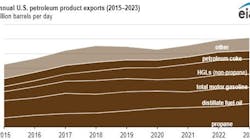A proposed production hike of 708,000 b/d by the Organization of Petroleum Exporting Countries (OPEC) failed to curb oil futures prices on world markets Wednesday, where traders had already factored in an increase of 500,000 b/d to cover current overproduction by members of the cartel.
On the New York Mercantile Exchange (NYMEX), the August contract for the benchmark blend of US light, sweet crudes jumped 72� to $31.35/bbl. The September contract also was up 41� to $29.90/bbl.
At the International Petroleum Exchange (IPE) in London, the August contract for North Sea Brent oil gained 31� to $29.33/bbl. By Thursday, that contract was trading at $29.56/bbl on the IPE, up 23� from Wednesday's close.
In overnight trading on the Singapore Exchange, the August contract for Brent oil gained 31� to $29.33/bbl, while the September position was unchanged at $28/bbl.
The average price for OPEC's basket of seven crudes also increased 17� to $29.14/bbl Wednesday.
OPEC's agreement to increase production to 25.4 million b/d, starting in July, did not satisfy speculators hoping for a boost of some 1 million b/d.
Optimists say the increase should help hold world oil prices in the $28-29/bbl range when the additional oil reaches markets in the third quarter. They expect non-OPEC producers�primarily Mexico and Norway, who have cooperated with OPEC in the past�to increase total production by as much as 300,000 b/d to help stabilize oil prices.
Mexico may raise its production as much as 75,000 b/d to defend its market share, said some observers.
But in Norway, producers and unions are embroiled in a labor dispute that could shut down some 3.2 million b/d of offshore production by Friday.
Meanwhile, both the American Petroleum Institute and the US Department of Energy reported unexpected changes in last week's crude and gasoline inventories.
Although analysts were expecting gains of 700,000-1 million bbl, API reported a 4.4 million bbl drop in US oil inventories for the week ending June 16. DOE put the loss at 4.6 million bbl.
On the other hand, API reported an increase of 357,000 bbl of unleaded gasoline supplies, while DOE figured a gain of 100,000 bbl. Analysts were anticipating a drop of 100,000-400,000 bbl. Total US stocks of reformulated gasoline were up 267,000 bbl to nearly 40.9 million bbl, said API officials. DOE reported a rise of 300,000 bbl to 39.6 million bbl.
US distillate stocks dropped a surprising 508,000 bbl last week, API reported. DOE officials put the loss at 1.5 million bbl. Analysts expected an increase of 500,000-900,000 bbl.
US refinery production rates increased to 95.4% last week from 94% the previous week, said API officials.
On the NYMEX Wednesday, the July contract for home heating oil was up 2.45� to 78.58�/gal. But unleaded gasoline contracts for the same period lost 1.35� to $1.0391/gal.
The July contract for natural gas jumped 27.1� to $4.38/Mcf on the NYMEX. On the IPE, the July gas contract was up 4� to the equivalent of $2.50/Mcf.
Shortly before the US market closed Wednesday, the American Gas Association reported US gas supplies increased by 64 Bcf to a total 1.49 tcf, less than the rise of 70-85 Bcf that analysts were expecting.
AGA officials said gas stocks are down as much as 25% from year-ago levels. Market fears of a 25% decrease in gas stocks going into the next winter season helped push gas futures prices to a 4-year high in May.
Meanwhile, the National Weather Service is forecasting above-normal temperatures this summer in the US Midwest, the biggest gas-consuming area.

